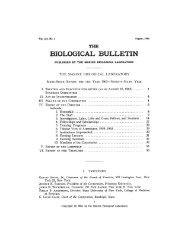General embryological information service - HPS Repository
General embryological information service - HPS Repository
General embryological information service - HPS Repository
You also want an ePaper? Increase the reach of your titles
YUMPU automatically turns print PDFs into web optimized ePapers that Google loves.
The author is of the opinion that, before a physico-chemical analysis of<br />
development can be attempted, the process should first be completely analysed<br />
and classified on the next higher level of integration, i.e. the strictly biological<br />
level. Accordingly, his theoretical conclusions are expressed largely in terms<br />
of protoplasmic continuity in the organism, geometrical relations of developing<br />
territories, localized growth processes, the function of space and cell number,<br />
morphogenetic competition between territories, etc.<br />
The book is in four parts, of which the first deals with cells and cell<br />
aggregations, with emphasis on unicellular organisms, colonial Protista, slime<br />
molds and sponges.<br />
The second part, which is by far the largest, discusses vegetative development<br />
and regeneration in lower invertebrates and Ascidians. This part contains a<br />
wealth of <strong>information</strong> from many different sources. It is concluded by a short<br />
theoretical summary.<br />
Part three constitutes an excursion into the field of meristematic development<br />
in higher plants. Although, of course, by no means exhaustive, it is very<br />
valuable because it directs the attention of the zoologist to the existence of<br />
parallel processes and problems, of which he is often insufficiently aware.<br />
Finally, the fourth part presents a selection of those aspects of the development<br />
from eggs, which are especially pertinent to the approach followed in the<br />
book as a whole. This part is too incomplete to have much value in itself, and<br />
should rather be regarded as an appendix.<br />
The book is profusely illustrated with good drawings, all especially made<br />
or re-drawn by the same artist. The figures have explanatory legends.<br />
Systematically arranged bibliographies are given at appropriate places throughout<br />
the book. There is a combined author, taxonomic and subject index, of<br />
which the subject component could perhaps have been more detailed.<br />
"INTERNATIONAL REVIEW OF CYTOLOGY''<br />
vols. 10 & 11, 1961<br />
Editors: G. H. Bourne and<br />
J. F. Danielli<br />
Academic Press Inc.<br />
New York and London<br />
Vol. 10: 423 pp., 107 figs., 19 tabs. Price: Vol. 10: $ 13.00<br />
Vol. 11: 356 pp., 156 figs., 8 tabs. Vol. 11: $ 11.00<br />
These are the two latest volumes of an important serial publication containing<br />
review papers on a variety of subjects in the field of cellular biology. The<br />
reason why the present volumes are announced in the "<strong>General</strong> Embryological<br />
Information Service" is that they contain several contributions which are<br />
concerned with developmental biology, viz.: Vol. 10: (1) "The mechanics and<br />
mechanism of cleavage", by L. Wolpert, 53 pages; (2) "The growth of the<br />
liver with special reference to mammals", by F. Doljanski, 27 pages; and<br />
(3) "Epidermal cells in culture", by A. G. Matoltsy, 38 pages; Vol. 11:<br />
(1) "Cytology of the developing eye", by A. J. Coulombre, 34 pages; (2) "Use<br />
of inhibiting agents in studies on fertilization mechanisms", by Ch. B. Metz,<br />
36 pages; (3) "The growth-duplication cycle of the cell", by D. M. Prescott,<br />
28 pages; and (4) "Histochemistry of ossification", by R. L. Cabrini, 24 pages.<br />
All papers contain extensive bibliographies. The books are well printed<br />
and well illustrated, and contain author and subject indexes.<br />
276
















